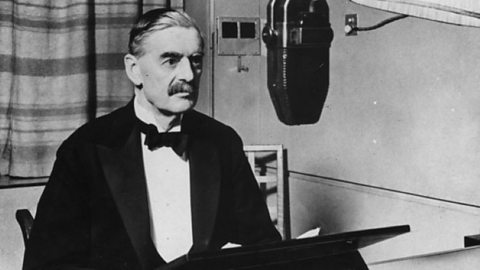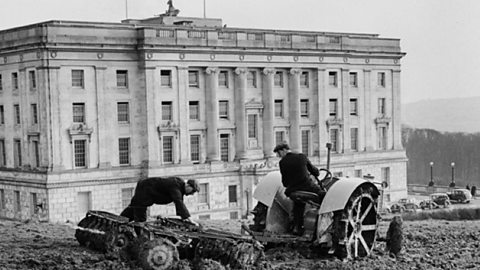De Valeraâs role in dismantling the Anglo-Irish Treaty
In March 1932, Fianna FĂĄilAn anti Anglo-Irish Treaty party when founded by Ăamon de Valera in 1926, Fianna FĂĄil has held power for most of the years since 1932. won the general election, partly because party leader Ăamon de Valera had promised to sever links with Britain if he became head of the government.
He formed a coalition governmentA government formed of more than one political party. government with the support of the Irish Labour Party.
De Valera aimed to dismantle the Anglo-Irish Treaty 1922Treaty (agreement) which established the Irish Free State in 1922. and achieve the maximum possible degree of independence from Britain.
To achieve this he wanted:
- To remove the links to Britain which existed through the post of Governor-GeneralThe representative of the monarch in a country that is still part of the British Empire, but is allowed to rule itself., the Oath of Allegiance, the Privy CouncilA group of senior politicians who advise the monarch. and membership of the CommonwealthAn association comprising the UK, its dependencies, and many former British colonies..
- To secure the return of the treaty portsThree ports at Berehaven, Cobh and Lough Swilly which Britain controlled under the terms of the Anglo-Irish Treaty. These were later transferred to Ăžą°ůąđ under the terms of the Anglo Irish Agreements, 1938..
- To control the Irish Free Stateâs foreign policy.
De Valera moved in stages to achieve his aims.
He adopted a cautious approach, keeping within the law in order to avoid British retaliation.
Step 1: Abolishing the Oath of Allegiance
The first stage was abolishing the Oath of Allegiance to the British monarch.
Actions
- After coming to power, de Valera discouraged the members of the new śŮĂĄžąąôThe lower house in the Irish parliament. from swearing the Oath of Loyalty to the British monarch.
- In January 1933, de Valera won a snap general election which, he claimed, indicated the public approved of his actions.
- In May 1933, the śŮĂĄžąąô passed the Removal of the Oath Act, eliminating the Oath of Allegiance.
Step 2: The post of Governor-General was removed
The post of Governor-General, held by James MacNeill, was undermined and then abolished.
Actions
- De Valera stopped inviting MacNeill to official events and Government Ministers snubbed him. Eventually the British government recalled him to London.
- De Valera replaced MacNeill with Fianna FĂĄilAn anti Anglo-Irish Treaty party when founded by Ăamon de Valera in 1926, Fianna FĂĄil has held power for most of the years since 1932. Domhnall Ua Buachalla and gave him the title an seanascal (Chief Steward). His powers were limited, he never lived in the Governor Generalâs official residence and he undertook no official duties â except signing bills into law.
- The Governor-Generalâs ability to refuse Royal AssentWhen the monarch approves a bill to make it a law. for bills passed by the śŮĂĄžąąôThe lower house in the Irish parliament. was removed in November 1933.
- The External Relations Act was introduced in December 1936 and resulted in the post of Governor General ceasing to exist.
Step 3: The role of the Privy Council was ended
The Anglo-Irish Treaty 1922Treaty (agreement) which established the Irish Free State in 1922. had allowed Free State citizens to appeal the decisions of Irish courts, in criminal cases, to the Privy CouncilA group of senior politicians who advise the monarch.in London.
In May 1933, the constitutionRules by which a country is organised and governed. was changed to stop people making such appeals.
In 1935, London challenged these actions before the Privy Council.
It ruled that the 1931 Statute of Westminster (a law which set out the basis for the relationship between the British Crown and the members of the CommonwealthAn association comprising the UK, its dependencies, and many former British colonies.) gave de Valera the power to make the changes he was making.
From that point on, the courts in the Irish Free State had the final say in law cases.
Step 4: The authority of the monarchy was reduced
De Valera used the 1936 abdicationWhen a Monarch resigns and gives up the throne. crisis to pass:
- The Constitution Act- which removed all reference to the British monarch and the Governor-GeneralThe representative of the monarch in a country that is still part of the British Empire, but is allowed to rule itself. from the constitutionRules by which a country is organised and governed.
- The External Relations Act - which abolished the King's authority in the Irish Free State and resulted in the post of Governor General ceasing to exist.
However, the Free State remained a member of the CommonwealthAn association comprising the UK, its dependencies, and many former British colonies. and the monarch was still recognised as the Head of the Commonwealth.
Question
What was happening in Britain at this time?
Britain was very worried by the constitutionRules by which a country is organised and governed.crisis, brought about by King Edward VIII's decision to marry the American divorcĂŠe, Mrs Wallis Simpson.
The government disapproved and the King abdicationWhen a Monarch resigns and gives up the throne. in December 1936.
There was increasing Nazi aggression in Europe, for example Germany's rearmament Manufacturing arms to support a growing military. and invasion of the Rhineland.
Britain did not want a hostile Irish Free State at its back when war in Europe seemed likely.
Step 5: Bunreacht na hĂžą°ůąđann, 1937
De Valera drew up a new constitutionRules by which a country is organised and governed., Bunreacht na hĂžą°ůąđann, in 1937.
This was because:
- By 1937, de Valera had made so many changes to the terms of the Anglo-Irish Treaty 1922Treaty (agreement) which established the Irish Free State in 1922. that the 1922 constitution, which outlined how the government of the Irish Free State operated, was out of date.
- He wanted to fulfil his 1932 election promise to sever links with Britain.
- He wanted to take advantage of Britain being distracted by internal and external problems.
Bunreacht na hĂžą°ůąđann made three significant changes:
- The new name of the state was Ăžą°ůąđ (Ireland).
- The leader of the Government was Taoiseach (Prime Minister).
- A (mainly ceremonial) President, elected every seven years, replaced the monarch as the Head of State. Douglas Hyde became the first President in 1938.
Key terms
- Irish was recognized as the official language.
- The Catholic Church was given a âspecial positionâ although âfreedom of conscience and the free profession and practice of religionâ was granted to other faiths.
- Article II claimed the right to rule over the whole island.
- Article III added that until partition ended, Ăžą°ůąđâs laws would only apply to the 26 counties currently governed by Dublin
Within five years of coming to power, de Valera had successfully removed many of the limitations on the independence of the Irish Free State.
Ireland had become a republicA country which is not ruled by a king or queen. in all but name.
Reactions to Bunreacht na hĂžą°ůąđann
Britain
The British had protested strongly at the actions taken by de Valera between 1932 and 1937.
They argued the Free State could not alter the terms of the Anglo-Irish Treaty 1922Treaty (agreement) which established the Irish Free State in 1922. except by mutual consent.
Yet, relations between Britain and Ăžą°ůąđ did not deteriorate as much as expected as London decided that these changes did not alter its relationship with Dublin.
Unionists
Bunreacht na hĂžą°ůąđann reinforced Unionistsâ insecurities as well as their determination to remain within the UK.
The Unionist government â based at Stormont since 1932 â strongly criticised Bunreacht na hĂžą°ůąđann.
In particular it:
- Condemned Articles II and IIIArticle II of the 1937 Irish constitution claimed the right of the Irish government to rule over the whole island. Article III of the constitution added that, until partition ended, Ăžą°ůąđâs laws would only apply to the 26 counties currently governed by Dublin.
- Denounced the particular mention of the position of the Catholic Church and the Irish language.
- Protested against the removal of all references to the British monarch in the new constitutionRules by which a country is organised and governed..
Unionists were also annoyed with the British for not trying harder to stop de Valera.
Lord Craigavon (as Sir James Craig was known after 1927) used the opportunity to call a snap general election in 1938, resulting in an increased majority for his party.
Nationalists
Some historians believe that northern nationalistPeople who believe their country should be independent from other nations. For example, Irish nationalists, who want Ireland to be fully independent of Britain. also had a lot to be dissatisfied with.
Despite the inclusion of Articles II and IIIArticle II of the 1937 Irish constitution claimed the right of the Irish government to rule over the whole island. Article III of the constitution added that, until partition ended, Ăžą°ůąđâs laws would only apply to the 26 counties currently governed by Dublin., it could be argued that, by removing almost all links with Britain and the CommonwealthAn association comprising the UK, its dependencies, and many former British colonies., the new constitutionRules by which a country is organised and governed. had actually strengthened partition/partitionedThe division of a country into two regions..
Nationalists were disillusioned because the constitutional changes had increased the determination of unionistA person who believes the union between Britain and Northern Ireland should continue. to stay part of the United Kingdom.
They were also increasingly disappointed in the Dublin government for not standing up and protecting their interests more.
They also felt isolated because the changes did not end discriminationTreating people differently on the basis of a particular characteristic, such as race, religion or sex. against them.
Ăžą°ůąđ
The new constitutionRules by which a country is organised and governed. was passed by a narrow majority in a referendumWhen a question is decided by putting it to a public vote.; this meant that de Valera had successfully removed the symbolic links between the Free State and Britain, but not all southern nationalistPeople who believe their country should be independent from other nations. For example, Irish nationalists, who want Ireland to be fully independent of Britain. were happy as the Free State was not a completely independent republic and partition/partitionedThe division of a country into two regions. remained.
However, de Valera had his reasons for not calling Ăžą°ůąđ a republicA country which is not ruled by a king or queen..
He wanted to avoid alienating Northern nationalists, unionistA person who believes the union between Britain and Northern Ireland should continue. and the British and to ensure he did not betray those who had fought for an all-lreland Republic at Easter Rising, 1916An armed rebellion, centred in Dublin during Easter 1916, by Irish republicans who wanted to end British rule in Ireland.
WATCH: From Irish Free State to Ăžą°ůąđ
Test your knowledge
More on Changing relations: Northern Ireland and its neighbours, 1920-49
Find out more by working through a topic
- count3 of 8

- count4 of 8
